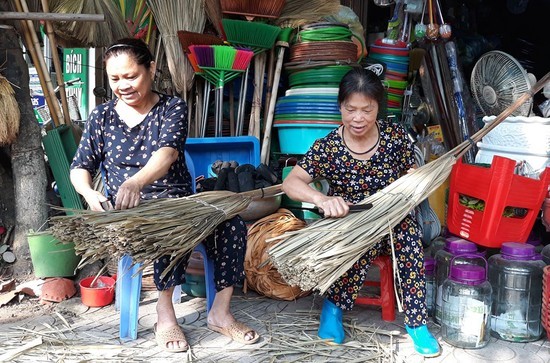Traditional markets alter in the digital age, according to Phu Tho.
- 203
- Digital
- 22:08 05/07/2023
DNHN - With the change in appearance, product quality, and businesspeople's dynamism and responsiveness to catch up with the digital age, the traditional market has been able to increase its competitiveness and avoid falling behind the competition.

The entire province is currently home to nearly 200 markets, the majority of which are occupied by small merchants who produce and sell goods directly. The business items at the market are diverse in type and design, focusing primarily on fresh food, clothing, and home appliances...
In recent years, the proliferation of supermarkets, convenience stores, and online shopping has led to the gradual decline of traditional markets. Nevertheless, due to the cultural values and traditions of each locale, the traditional market will always occupy a particular place in contemporary social life.
There are approximately ten stable traditional markets in Lam Thao district's communes and towns. Typically, the market operates in sessions on set days. The markets meet an average of five to seven times per month, primarily in the morning.
Even though it is a rural market, the majority of customers are locals, and sellers have gradually adopted modern business practices such as cashless payment and selling through social networks. such as Facebook, Zalo... (online sales), and even simultaneous delivery. Ms. Nguyen Thu Thao, owner of a pork stall at a market in Hung Son town, Lam Thao district, shared: Sales hours are not only sold directly at the market; those who are busy and unable to purchase will call, and I will then deliver the goods to them. Currently, it is difficult to retain customers if you do not sell a variety of products.

Recognizing the importance of traditional markets in the distribution and retail sale of goods and in meeting the shopping needs of the populace, localities have increased the mobilization of resources to renovate and upgrade markets in recent years. As a result, permanent or semipermanent markets have been constructed with stalls that guarantee space and cleanliness.
Specifically, small merchants on the market promote business activities in the direction of modernity by developing a variety of models that accommodate consumers' shopping needs. To catch up with the trend, they are gradually adopting online sales channels via mobile phones and the Internet.
Many small merchants have actively transitioned to two forms of parallel business: direct sales at stalls and online sales, while catching up with technology trends, from vegetables and beans to meat and clothing. Transfer payments and scan QR codes with ease and convenience.
In addition, the non-cash payment helps the seller avoid risks such as torn currency, counterfeit currency, and time wasted exchanging change for customers. Ms. Nguyen Thi Nhu Quynh, a ward of Minh Phuong, shared: If you previously went to the market without bringing money back, you now only need a phone to purchase a bunch of vegetables for 10,000 VND, and you can also pay with your account. This makes me happy because it makes shopping convenient and satisfying.
It can be seen that a large number of people continue to exchange, buy, and sell goods at the traditional market due to their longstanding shopping habits. The traditional market has been able to avoid falling behind modern life thanks to business professionals' adoption of digital technology.
P.V
Related news
- Connecting Leaders, Shaping the Future: Strategic Leadership Planning Meeting – CorporateConnections Hanoi A
- Sunlight - Unilever Vietnam Recognized for Outstanding Contributions to the National Initiative Supporting Women Entrepreneurs
- Deputy Prime Minister Nguyễn Chí Dũng: “The country’s major challenges weigh heavily on my mind — and we must resolve them together.
- Unitsky String Technologies signs cooperation agreements with three Vietnamese partners, opening a new direction for smart mobility and sustainable development
- When artists do business – livelihood is no poetry!
- Before the D‑day to abolish flat‑rate tax: Fear of technology and costs leave small traders struggling to adapt
- Vietnamese enterprises at a crossroads: the impact of a potential US–China deal
- "Digital technicians" must not be forgotten if Vietnam aims to meet its strategic goals
- HDBank: Impressive profit growth, leading in profitability and advancing international integration
- TNI King Coffee sued for over VND 5 Billion in unpaid debts
- VINASME and Jeonnam Technopark Sign MOU on technology cooperation, human resource training, and trade promotion
- Vietnamese entrepreneurs strengthen ASEAN connectivity in the digital iIntegration era
- Prime Minister: Vietnam aims to become a regional logistics hub
- Vietnam upgraded to Secondary Emerging Market by FTSE Russell
- Hanoi’s economy grows 7.92% in first nine months of 2025, FDI surges nearly threefold
- Vietnam’s strong gdp growth fails to ease labor market distress
- US tariffs on Brazil propel Vietnam’s pangasius into global spotlight
- VietLeap AI Accelerator launches: A strategic springboard for Vietnam’s AI startups
- CICON expands strategic alliances: A new step forward in Vietnam–Korea business connectivity
- What must Vietnamese enterprises do to maintain their position in the global supply chain?
Đọc thêm Digital
Cybersecurity talent & digital entrepreneurs: Vietnam racing to fill a 700,000-person workforce gap
The “Student Cybersecurity Festival & Final Round of the 2025 Vietnam Cybersecurity Student Competition” (CSCV 2025), held on November 15 in Hanoi, became a major focal point for the technology community.
"Digital technicians" must not be forgotten if Vietnam aims to meet its strategic goals
Vietnam is facing a serious shortage of skilled technical operators. Without retaining its “digital technicians,” the ambition to become an AI hub may never materialize.
Prime Minister: Vietnam aims to become a regional logistics hub
At the 2025 FIATA World Congress in Hanoi, Prime Minister Pham Minh Chinh emphasized logistics as one of Vietnam’s key growth drivers, highlighting major infrastructure investments and commitments to attract global investors.
VietLeap AI Accelerator launches: A strategic springboard for Vietnam’s AI startups
The program is expected to select 10 to 15 high-growth potential AI startups with clear funding needs.
Vietnam advances cybersecurity law to boost digital sovereignty and business resilience
In a significant step towards strengthening Vietnam’s digital defenses, the National Assembly Standing Committee convened on September 23 to review the draft revised Cybersecurity Law.
Vietnam embraces digital tools to modernize public administration
Across Vietnam, local governments are turning to digital platforms, QR codes, and AI-powered assistants to modernize public services—making them faster, more transparent, and more accessible to citizens.
Administrative procedures for establishing the national technology exchange reduced to one application set
Deputy Prime Minister Nguyen Hoa Binh has just signed Decision No. 2108/QD-TTg approving the plan to streamline internal administrative procedures within the state administrative system under the management of the Ministry of Science and Technology.
Government’s plan to implement Law on Digital Technology Industry approved
The Government has approved a plan to implement the Law on Digital Technology Industry (the Law) scheduled to take effect from January 1, 2026, according to a report from the Government News.
Shark Nguyễn Hòa Bình: Hanoi will become the capital of startup innovation.
Recently, in Hanoi, the seminar “Formulating City People’s Council Resolutions to Promote Science and Technology Development in Connection with the Implementation of Politburo Resolution No. 57-NQ/TW and the Capital Law No. 39/2024/QH15” was held.
Da Nang proposes semiconductor cooperation with Oregon (USA)
Leaders of Da Nang City have proposed that Oregon (USA) and the city explore cooperation opportunities in priority sectors such as semiconductor technology, logistics, and the development of Free Trade Zone (FTZ) infrastructure.











